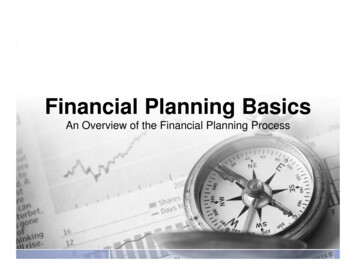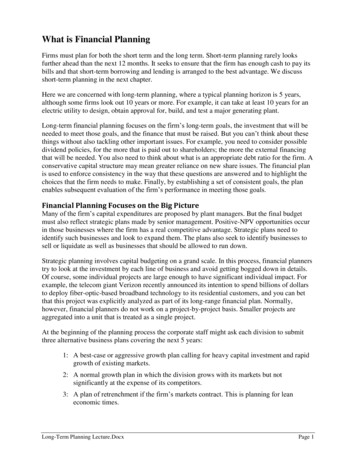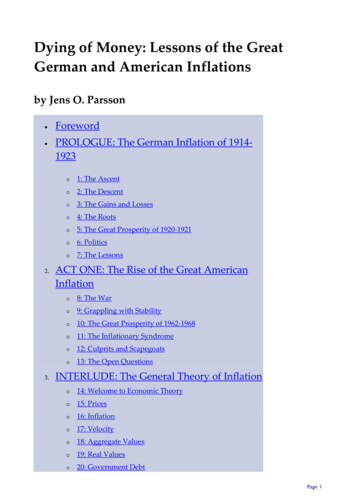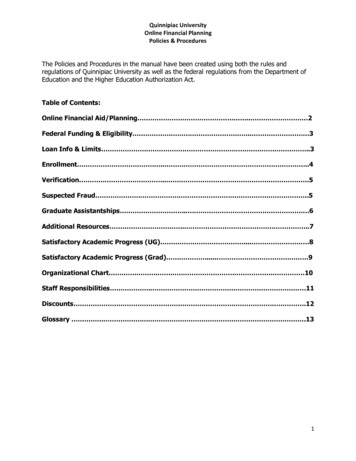
Transcription
Financial Planning BasicsFinancial Planning BasicsAn Overview of the Financial Planning Process
The Ground to Cover Setting goalsBudgetingEmergency fundInsuranceUsing creditInvestingTax planningSaving for collegeRetirement planningEstate planning
Setting Your Goals
How SMART Are Your Goals? Specific Measurable Attainable Relevant TimelyWrite down and prioritize your goals.
BudgetingIncome1.2.3.4.5.PaycheckRental incomeGovernment benefitsInterestInvestment income Expenses1. Fixed expenses2. Discretionary expenses SurplusDeficit
An Emergency FundWhere youAn emergencykeep yourfund is theemergencyfoundation forfund isany successfulimportantfinancial plan.
Risk Management with InsuranceCommon types of insurance that help protect you andyour assets from different risks: Health insuranceAuto insuranceLife insuranceProperty insuranceLiability insuranceDisability insuranceLong-term care insurance
Using Credit The three Cs of credit CapacityCharacterCollateral How creditors determine“Remember that credit is money”Benjamin Franklinyour creditworthiness Credit application Credit report Credit score
Debt Using credit creates debt Types of debt SecuredUnsecured Important considerations AmountTermRate
InvestingSpeculating?Saving?Investing--A carefully plannedand prepared approach tomanaging money, with the goalof accumulating the funds youneed
Risk Tolerance Understand risk-rewardtradeoff Personal tolerance forrisk Ability of investment planto deal with potential loss
Growth, Income, and Stability Growth: Increase in marketvalue Income: Payments of interestor dividendsStability Stability: Protection of originalinvestment Increased emphasis on onearea may reduce emphasis onothersIncomeGrowth
Income Tax ConsiderationsPretax DollarsTax-Deferred Growth Deductions are madefrom your paycheckbefore taxes arecalculated The result can be lowerout-of-pocket costs Some examples: No taxes are due until fundsare withdrawn from theaccount In certain cases, qualifieddistributions are tax free Some examples: Health or dependent care Transportation costs Retirement plancontributions (e.g., 401(k)) 529 college savings andprepaid tuition plans Retirement plans--traditionaland Roth IRAs Penalty tax applies in somesituations (early withdrawals,nonqualified distributions)
The Value of Tax DeferralTaxable vs. Tax-Deferred Growth 10,000 invested in 70,000 57,435( 41,353 after tax) 60,000 50,000Year 1 6% annual growthrate 40,000 30,000 28% tax rate 20,000 35,565 10,000 0024681012Taxable investment141618202224262830 Taxes paid withaccount assetsTax-Deferred InvestmentThis hypothetical example is for illustrative purposes only, and its results are not representative of any specific investment or mix of investments.Actual results will vary. The taxable account balance assumes that earnings are taxed as ordinary income and does not reflect possible lowermaximum tax rates on capital gains and dividends which would make the taxable investment return more favorable thereby reducing the differencein performance between the accounts shown. Investment fees and expenses have not been deducted. If they had been, the results would have beenlower. You should consider your personal investment horizon and income tax brackets, both current and anticipated, when making an investmentdecision as these may further impact the results of the comparison. This illustration assumes a fixed annual rate of return; the rate of return on youractual investment portfolio will be different and will vary over time, according to actual market performance. This is particularly true for long-terminvestments. It is important to note that investments offering the potential for higher rates of return also involve a higher degree of risk to principal.
Saving for College529 planssavings plans CollegeTax-deferredgrowth andtax-free earnings potentialIndividual accountPre-established portfolios Withdrawalsnot used for collegeReturns notguaranteedsubjectto income tax andCan beat any collegea usedpenalty Can join any state’s plan Fees and expenses witheach tuitiontype ofplanPrepaidplans Prepay tuition today Returnguaranteed--inof tuitionInvestors should consider the xpenses associated with 529 plans carefully before investing. More Limitedyour state’splan statement,information about 529 plans is availablein thetoissuer'sofficialwhich should be read carefully before investing.In-state publicAlso,collegesbefore investing,consider whether your state offers a 529 plan that provides residents withfavorable state tax benefits. The availability of the tax or other benefitsmentioned may be conditioned on meeting certain requirements.
Retirement: Start Now Don’t put off planning and investing for retirement 3,000 annual The sooner you start, the longer your investments have a investmentchance toat 700,000 679,500grow6% annual 600,000growth, Playing “catch-up” later can be difficult and expensiveassuming 500,000reinvestment of 400,000all earnings and 300,000 254,400no tax 800,000 200,000 120,000 100,000 020253035Age 2040Age 354550556065Age 45This is a hypothetical example and is not intended to reflect the actual performance of any investment. Thisillustration assumes a fixed annual rate of return; the rate of return on your actual investment portfolio will bedifferent and will vary over time, according to actual market performance. This is particularly true for long-terminvestments. It is important to note that investments offering the potential for higher rates of return also involvea higher degree of risk to principal.
Retirement: Basic Considerations What kind of retirementdo you want? When do you want toretire?Whendo youwant toWhatkindof retirementHow longwillretire?doyou want?retirementlast? How long will retirementlast? The earlier you retire, yshorter theof uhaveaccumulatehobbiesincreasefunds and the longerAbilitytolive whereyou ,incurrenthome,lastyears orhome)morevacationSocial Securityisn’tOpportunityto provideavailable untilage 62orfinanciallyfor childrenMedicare eligibilitygrandchildrenbegins at age 65
Retirement: Tax-Advantaged SavingsVehicles Tax deferral can help yourmoney grow Take full advantage of401(k)s and other employersponsored retirement plans Contribute to a traditional orRoth IRA if you qualify 10% additional penalty taxapplies for early withdrawals
Estate Planning Fundamentals IntestacyWillsTrustsPlanning for incapacity
Estate Planning: Intestacy Intestacy laws vary fromstate to stateTypical pattern of distributiondivides property betweensurviving spouse andchildrenYour actual wishes areirrelevantMany potential problems
Estate Planning: Wills A will is the cornerstoneof an estate plan Directs how yourproperty will bedistributed Names executor andguardian for minorchildren Can accomplish otherestate planning goals(e.g., minimizing taxes) Must be written, signedby you, and witnessed
Estate Planning: Planning for Incapacity Incapacity can strikeanyone at any time Failing to plan means acourt would have toappoint a guardian Lack of planningincreases the burden onyour guardian Your guardian’s decisionsmight not be what youwould want
There’s a Lot to ConsiderAsk questions, and start planning now.
Disclaimer IMPORTANT DISCLOSURES Broadridge Investor Communication Solutions, Inc.does not provide investment, tax, or legal advice. The information presented here isnot specific to any individual's personal circumstances. To the extent that thismaterial concerns tax matters, it is not intended or written to be used, and cannot beused, by a taxpayer for the purpose of avoiding penalties that may be imposed bylaw. Each taxpayer should seek independent advice from a tax professional basedon his or her individual circumstances. These materials are provided for generalinformation and educational purposes based upon publicly available information fromsources believed to be reliable—we cannot assure the accuracy or completeness ofthese materials. The information in these materials may change at any time andwithout notice.
The Value of Tax Deferral 10,000 invested in Year 1 6% annual growth rate 28% tax rate Taxes pa











